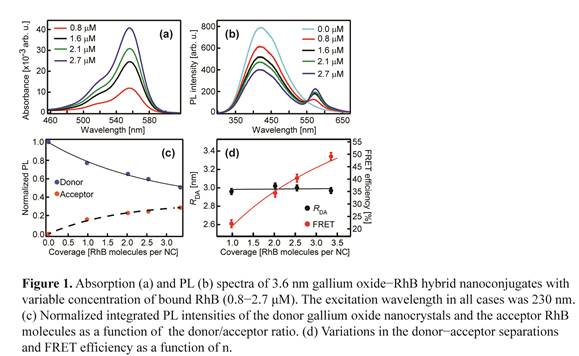Reports: ND453856-ND4: Defect-Mediated Manipulation of Excited-State Reactions at the Metal Oxide Surfaces in Solution
Pavle Radovanovic, PhD, University of Waterloo
In the first reporting period of the grant we have focused on controlling the formation and interactions of native defects in nanocrystalline Ga2O3, and detailed quantitative understanding of their coupling with surface-bound organic species via FRET. We have previously demonstrated the synthesis of metastable γ-Ga2O3 nanocrystals, which represent an excellent model system for this study because of their strong size-tunable photoluminescence that has a lifetime of several milliseconds, orders of magnitude longer than typical excited-state reactions. The observed γ-Ga2O3 nanocrystal emission arises from the recombination of an electron trapped on an oxygen vacancy site with a hole trapped on a gallium-oxygen vacancy pair site, and is known as the donor-acceptor pair (DAP) recombination.
As a part of this grant, we have prepared a series of Ga2O3 nanocrystals having varying average sizes and density of native defects acting as FRET donors, which were conjugated with different dye molecules (FRET acceptors), in order to quantitatively investigate the parameters involved in the energy transfer process relevant for the proposed studies. Specifically, we have characterized the efficiency of the energy transfer and the corresponding donor−acceptor separations for different average nanocrystal sizes and dye molecule surface coverages (Figure 1). We have shown that for approximately three Rhodamine B molecules bound per nanocrystal, the energy transfer efficiency increases from 23 % to 49 % by decreasing the NC size from 5.3 to 3.6 nm. The FRET efficiencies of 23 % and 49 % correspond to the estimated donor−acceptor distances of ca. 3.5 and 3.0 nm, respectively. Similar trends were observed for ATTO 590-conjugated Ga2O3 nanocrystals, although ATTO 590 was shown to be a more effective energy acceptor owing to a larger molar extinction coefficient in the conjugated form.
A significant part of our efforts was focused on discovering new ways of controlling the defect formation and interactions in Ga2O3 nanocrystals, related to their application in excited-state photocatalysis. For example, we have shown that formation of native defects can be controlled by incorporation of europium ions with mixed oxidation states (Eu2+ and Eu3+). The formation of divalent europium is achieved by in situ reduction of Eu3+ during the nanocrystal synthesis in oleylamine, acting as a coordinating solvent and a reducing agent. The Eu2+ ions are proposed to be stabilized internally owing to the attractive interaction with oxygen vacancies, while Eu3+ dopants partly reside in the nanocrystal surface region. The attractive interactions between Eu2+ and oxygen vacancies results in an increased concentration of DAP centers responsible for excitation of surface-bound species by FRET mechanism.
We also worked on theoretical modelling of the defect interactions through simulation of the photoluminescence decay dynamics of Ga2O3 nanocrystals prepared under different conditions. This work has also yielded some interesting new results, including the importance of the exclusion volume and the smallest separation between donor and acceptor sites.
The ACS-PRF grant has been a key factor for the ongoing success of this project. It provided partial support for several graduate students and a postdoctoral fellow in my group, and enabled them to undertake new ideas and nurture their creativities. The knowledge and experience they gained during their involvement in the project will certainly have long lasting influence on their careers. This grant also helped me as a PI pursue new problems and maintain high level of research in a competitive environment. This work has already resulted in two research papers (J. Phys. Chem. C and Chem. Mater.), and helped obtain a major grant from the Natural Sciences and Engineering Research Council of Canada (NSERC).












